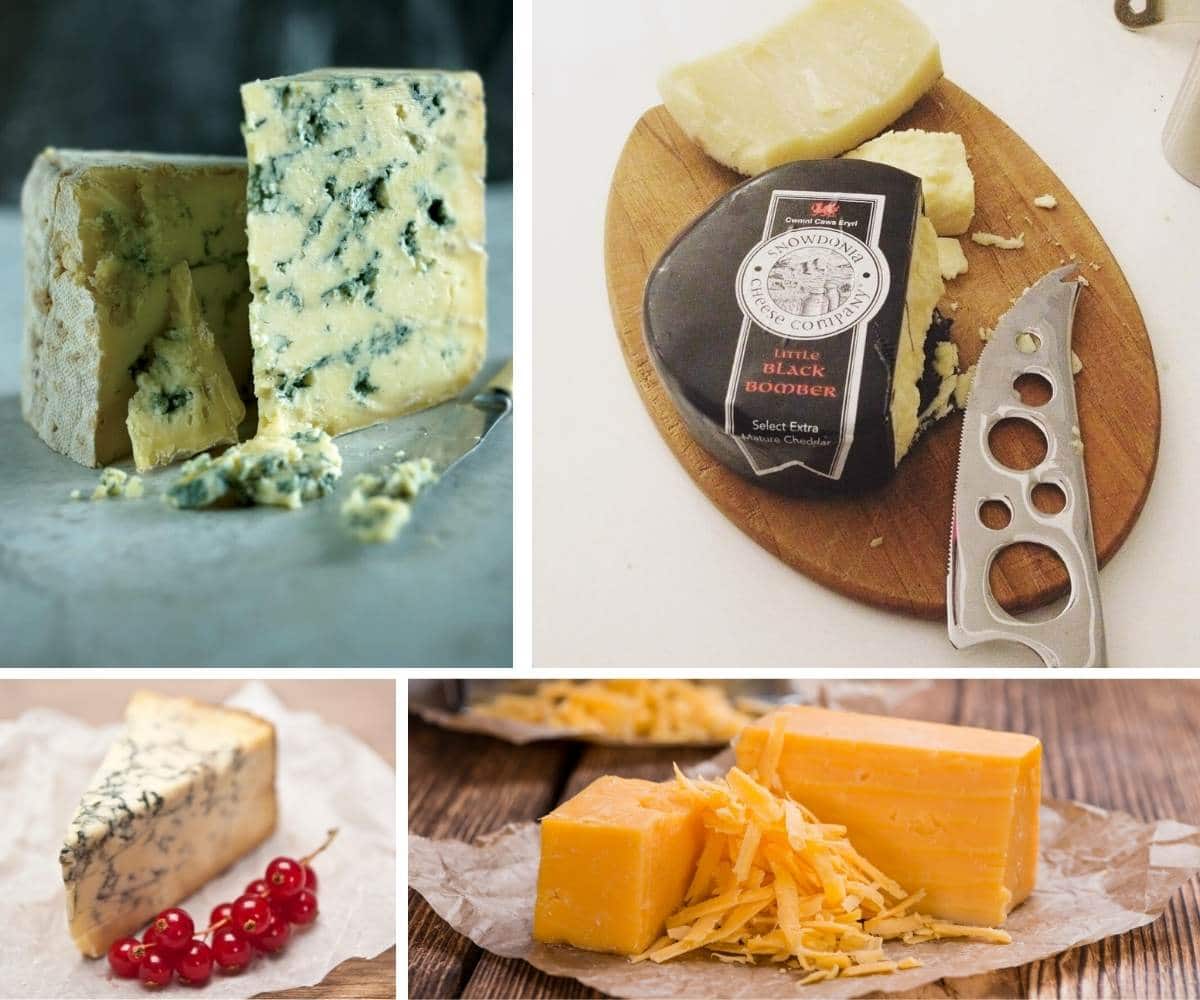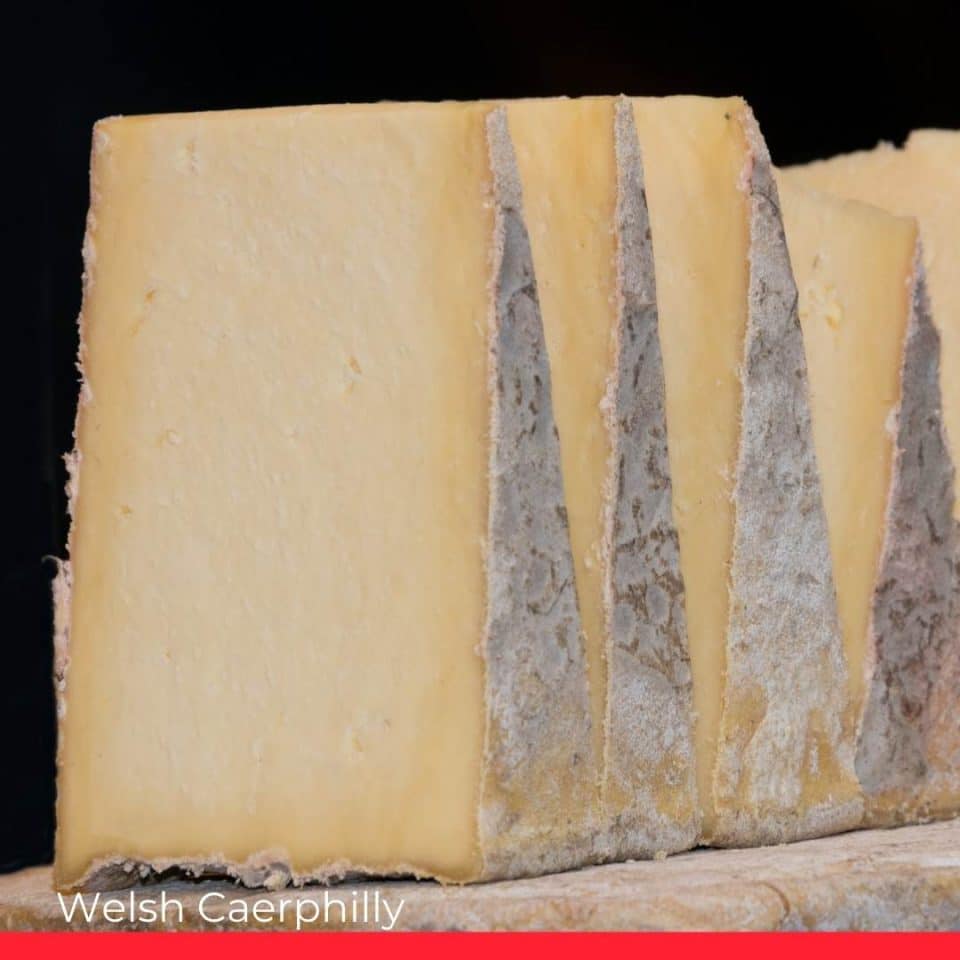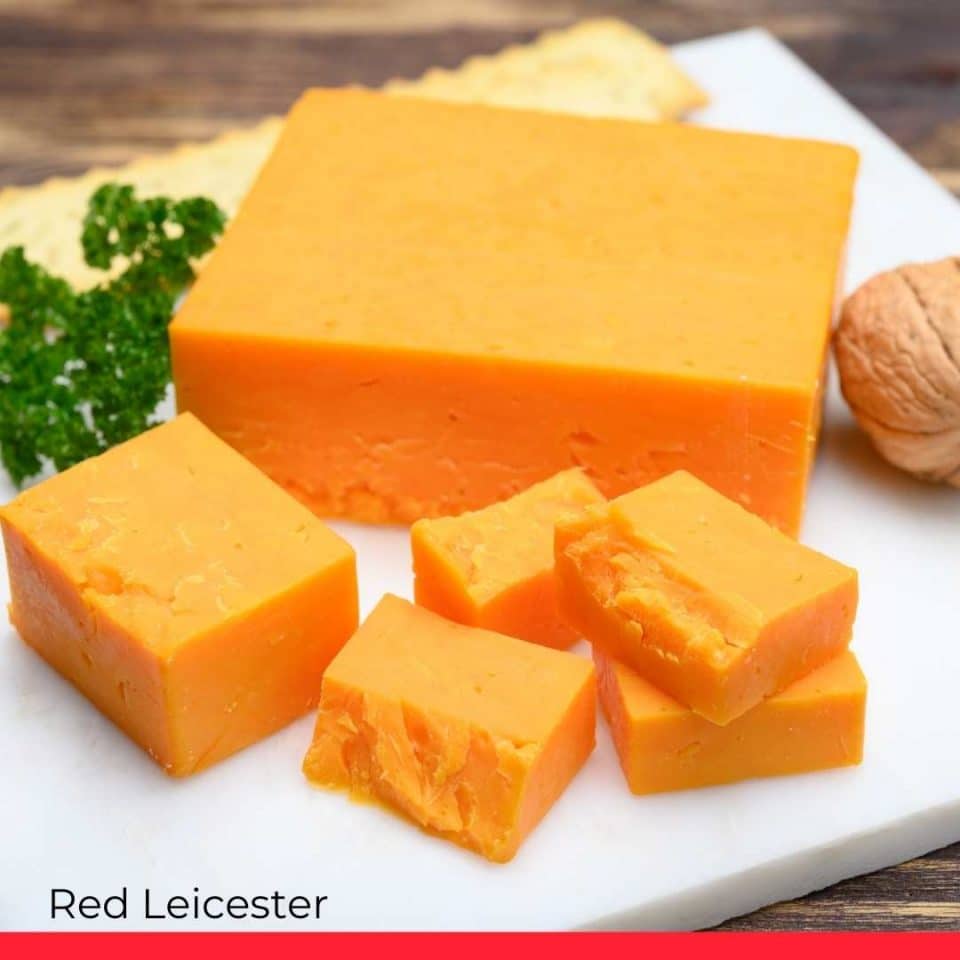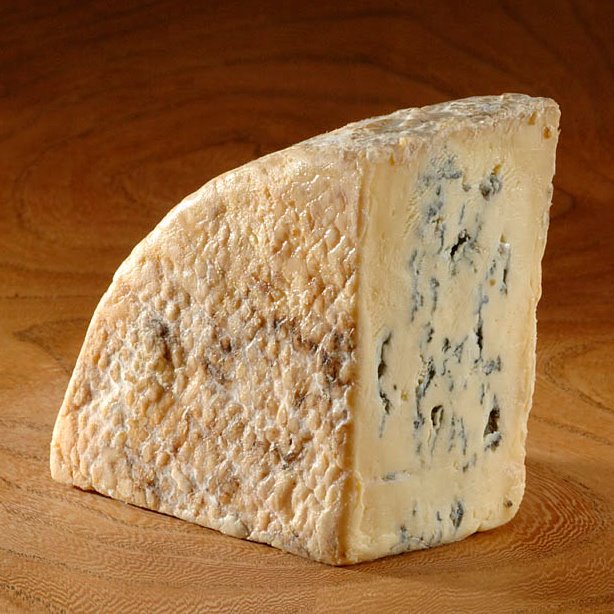20 Tasty British Cheeses You Must Try!

When you’re standing at a cheese counter pondering what British cheese to buy, how many come to mind? Cheddar is the obvious choice. But did you realize that the British Isles have a tradition of cheese-making that goes back centuries, and every region has its distinctive speciality?
In addition, a new generation of contemporary artisanal cheese makers is using modern techniques to create fascinating variations on much-loved favorites and they carry away multiple awards at international cheesemaker competitions.
Here are 20 of the best, from every corner of the British Isles, for you to look out for and taste. Enjoy the journey!
1. Cheddar

This versatile cow’s milk cheese has become one of the most famous cheeses in the world today. Cheesemakers Somerset Village of Cheddar in the southwest corner of England have been making it since the 12th century.
Authentic Cheddar has a smooth, tight texture and a full flavor. It’s perfect for cooking. Adding a depth of flavor to cheese sauces, making crispy toppings for backs and casseroles, or mixing with eggs to give a strong cheesy tang to omelets and quiches, it has endless uses. Cheddar’s hard to beat as a sandwich cheese, on some fresh crusty bread with slices of juicy tomato and perhaps some sliced ham.
Young Cheddar has a smooth texture and a mild taste, but as it matures, it develops a sharper flavor and becomes more crumbly. It ranges from the palest cream to yellow in color.
Although authentic, flavorful Cheddar has its origins in the tiny village that gave it its name, and that name has never been protected. This has led to Cheddar clones being mass-produced the world over to grace the supermarket shelves in most countries. Don’t let these low-quality imitations deter you; authentic Cheddar is a premium product and is justly acknowledged as one of the world’s great cheeses.
2. Stilton

Another English classic. Genuine Stilton cheese is a blue-veined cheese produced exclusively in the midland counties of Derbyshire, Nottinghamshire, and Leicestershire. Often referred to as The King of English Cheeses, it’s a classic dessert cheese, traditionally served after formal dinners, accompanied by a glass or two of fine port wine.
It’s more versatile than its upmarket reputation might suggest. The crumbly texture makes it ideal for soups, salads, and dips. It’s also one of the few kinds of cheese that freeze well.
If you’re not a lover of tangy blue cheeses, White Stilton is an alternative. It’s a full-fat creamy cheese with a natural crust that’s typically made into a roll. In recent times, enterprising cheesemakers have started to add unique twists, so you may find White Stilton flavored with mango, apricots, or even ginger.
White Stilton Gold, a limited edition Christmas variety of the White Stilton cheese, is one of the most expensive cheeses in the world.
Mature Blue Stilton is characterized by its creamy color, marbled with blue or sometimes green-blue veins of pungent mold. People tend to love it or hate it, but you need to try it.
3. Cheshire

Cheshire is a cow’s milk cheese. Although it originated in the northwest of England, it’s now produced in Scotland. This cheese has such a long history that it’s even mentioned in the 11th-century Domesday Book.
Cheshire cheese has a dense, crumbly texture due to the fact that it was traditionally made with milk from cattle that were grazed on local salt marshes. The salt in their milk slowed down the ripening process of the cheese and created a distinctive texture as a result.
Authentic Cheshire cheese is white. Cheaper versions may be dyed orange with annatto. It has a moist milky bite that also has a slight tang. Cheshire cheese is versatile: you can grill it, use it to top bakes, or add it to soups and salads.
4. Little Black Bomber

This is a modern Welsh take on extra mature Cheddar, produced exclusively in the seaside town of Rhyl, which is surrounded by the green slopes of the Snowdonia mountains. Little Black Bomber gets its name from the black wax which covers the individual cheeses.
It’s a hard cheese made with the milk of pasture-fed cows. It has a smooth and creamy texture and an aroma reminiscent of caramel. It’s the perfect accompaniment to a glass of full-bodied red wine.
Although this artisanal cheese is only produced in small quantities each year by a single dairy, it deserves mention just because it’s won so many awards, including a Super Gold at the prestigious Mondial Fromage in France.
5. Double Gloucester

As the name suggests, this hard cheese originates in the county of Gloucester on the Welsh border. It got its name because it’s produced using full fat cream from one day’s milking, with the addition of milk from the following day added later.
A round of Double Gloucester cheese is twice the thickness of that of Single Gloucester, which could be an alternative explanation of the origin of the name.
Young Double Gloucester is smooth, almost buttery, but is typically left to harden for at least four months. Mature rounds are used in the traditional Copper’s Hill Cheese-Rolling event, a bizarre race with obscure origins.
This apricot-colored cheese has a rich, nutty flavor, with a hint of citrus. It’s best enjoyed with a glass of craft ale, some crusty bread, and perhaps some sliced ripe local pears as a contrast.
6. Welsh Caerphilly

Aka Traditional Welsh Caerffili, this cheese has been produced in Caerphilly and around the south and west of Wales since 1830. Made with pasteurized cow’s milk, it has a high moisture content and a white, flour-dusted rind.
Caerphilly cheese was especially popular in mining communities, as the rind allowed it to be eaten with hands encrusted with coal dust. In addition, the curd helped to replenish minerals that would be lost during long, punishing hours spent working underground.
When young, the texture of Caerphilly is moist and supple. It has a distinctively fresh, lemony flavor due to the quality of the local milk.
7. Red Leicester

A British Cheddar-style cheese named after the county where it’s been produced since the 17th century, this orange cheddar-style cheese is made from raw cow’s milk and colored with annatto.
It’s wrapped in cloth and typically takes 6-9 months to mature. It has a rich aroma and a sweet caramel flavor. It’s best enjoyed with sweet, full-bodied white wines: Muscadet and Vouvray are ideal partners.
8. Blue Wensleydale

This was invented in the 19th century by cheesemaker Thomas Nuttall in the town of Hawes. Under the rind, which is wrapped in cloth, it has a hard, dense texture and is marbled with blue veins.
It’s matured for at least six months before use. The mellow creamy flavor makes it a perfect addition to a pear and walnut salad or partnered with prosciutto on a warm baguette fresh from the oven.
9. Isle of Wight Blue

This modern British blue cheese is made from the pasteurized milk of local cows on the tiny Isle of Wight. Produced in tiny quantities by artisan cheesemaker Rich Hodgson, it’s won multiple accolades, including the title of Best English Cheese at the World Cheese Awards.
This blue cheese is only aged for 3 to 5 weeks, so when young, it has a mild flavor. However, this gets stronger with time, and after weeks it is quite intense. The moldy rind can be grey, blue-green, or white, and the cheese itself is creamy and dense.
11. Barkham Blue

Barkham Blue is produced by Two Hoots Cheese in the county of Berkshire to the west of London. What makes this modern blue cheese so special is that it’s made from the famous creamy milk of Jersey and Guernsey cows.
Because of this, it has a smooth, almost buttery texture and a hint of spiciness. It’s covered with a rind of natural mold and is shot through with deep blue-green veins.
Another award winner, Barkham Blue lifted the title of Supreme Champion at the 2015 World Cheese Awards.
12. Traditional Ayrshire Dunlop

This is a cylindrical, hard cheese made from the milk of Ayrshire cows. It’s traditionally a soft yellow color with a smooth surface that can feel moist when touched. It comes in mild, mature, or extra mature varieties.
The youngest is aged for at least six months, while the extra mature one can take up to 18 months for the sharper and creamier flavors to appear.
13. Dovedale

This cylindrical, blue-veined soft cheese is made with full fat cow’s milk in the rolling hills of the Peak District. The mildest British blue cheese, it has a soft yet distinctive flavor that’s ready to enjoy after only three to four weeks.
While most British cheeses are dry salted, Dovedale is soaked in brine. It goes well with figs and prosciutto and perhaps some dry white wine.
14. Sussex Slipcote

Produced in Horsted Keynes, a village in West Sussex on the south coast of England, this is a fresh sheep’s milk cheese.
As it’s only ripened for ten days, giving it a fresh, clean, and tangy taste. It has a moist, almost fluffy texture and is sometimes flavored with garlic, peppercorns, or fragrant herbs.
15. Exmoor Blue

An artisanal soft blue cheese with a blue and white moldy coating, this is made with the supremely rich and creamy full-fat milk from Jersey cows. While it’s ripening for between three and six weeks, it’s turned every two days. Its texture is creamy and soft, with a slight hint of a peppery aftertaste.
Because Exmoor Blue is made with vegetarian rennet, it’s suitable for vegetarians (though not, of course, for vegans). It melts well, so it makes a great topping for baked potatoes. Paired with a robust red wine, it’s perfect!
17. Strathdon Blue

This Scottish blue cheese has been produced by the Stones family in the town of Tain since 1851. It’s still made from the pasteurized milk of a single herd of local Ayrshire and Holstein-Friesian cows.
Mottled with blue veins, it has a rich and creamy texture, but what makes Strathdon Blue stand out from the other blue cheeses on this list is the distinctive peppery flavor, which makes it perfect for crumbling or melting over steaks and burgers.
Strathdon Blue is produced using vegetarian rennet, so it’s suitable for vegetarians. Enjoy it with a glass of sherry or port.
18. Tintern

From the small town in Monmouthshire, Wales, this is a traditional Welsh Cheddar-style cheese made from pasteurized cow’s milk. Underneath the distinctive green waxy covering, the texture is dense and creamy.
It’s flavored with chives and local shallots to create a slightly sweet and tangy cheese that will grace any plowman’s lunch. Tintern is ideal for adding interest to soufflés and omelets. And it’s a perfect partner for a glass of craft beer or a glass of robust red wine.
19. Isle of Mull

You can’t get much further north than the archipelago of Inner Hebrides. This is a Cheddar-style cheese made from the raw milk of the local cattle herds and traditionally left to age for 18 months. Underneath its cloth-wrapped natural rind, it has an unusually chewy yet creamy texture and a pungent, yeasty aroma.
20. Ogleshield

Ogleshield is a handmade cheese from Cadbury, Somerset. It’s produced with raw Jersey cow’s milk, famous for its creamy, high-fat content. The rind is rinsed in brine every three days, which makes it soft, sticky, and somewhat pungent.
The texture of the cheese is soft and buttery, and it has a wonderfully sweet, fruity flavor. It is perfect for sauces and dishes such as raclette or fondue, as it melts so beautifully.
Related: British Food: 16 Traditional Dishes You Have to Try
Related: Most Popular Irish Cheeses
Related: 32 Most Popular French Cheeses
Related: 25 Most Popular Dutch Cheeses


